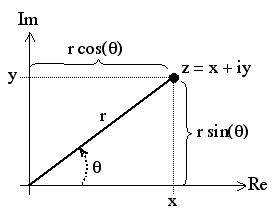
| Rectangular Coordinates |
Polar Coordinates |
So how do we convert between rectangular and polar coordinates??
| Rectangular to Polar Coordinates Given z = a + bi, to convert to polar coordinates, one must simply use the following: r = (a2 + b2)(1/2). Notice it's like doing the pythagorean theorem! θ = arctan (b/a). |
Polar to Rectangular Coordinates Given (r,θ) we can convert z into rectangular coordinates (a,b) by plugging the values of r and θ into a = rcosθ and b = r sinθ |
Find the modulus and argument of:
6
8i
-4+4i
2-7i.
You can practice on your own and check your answers here:
Original applet - Converting Polar and Rectangular Coordinates
Need extra help? Check this out: Complex Numbers
